Small Valve Maintenance & Repair
Valves control the flow of fuel vapor into the combustion chamber and the flow of exhaust gases leaving the engine. Faulty or dirty valves may stick and can develop pits, cracks or grooves that cause the engine to lose power and fuel efficiency.
Whether you’re having trouble with your engine or wanting to go through your routine valve maintenance, make sure you have our step-by-step guide on how to check your engine valves. From removing the valve, to cleaning for inspection, find information for valve maintenance for your Briggs & Stratton engines.
![]() WARNING: Always read the engine and equipment manual(s) before starting, operating, or servicing your engine or equipment to avoid personal injury or property damage. See an authorized dealer or contact Briggs & Stratton if you are unsure of any procedure or have additional questions. Find all Engine Safety Warnings.
WARNING: Always read the engine and equipment manual(s) before starting, operating, or servicing your engine or equipment to avoid personal injury or property damage. See an authorized dealer or contact Briggs & Stratton if you are unsure of any procedure or have additional questions. Find all Engine Safety Warnings.
If you’re looking for a specific solution or step into valve repair, jump down to the section for step-by-step instructions.
How to Remove Small Engine Valves for Inspection
How Do I Check or Repair My Engine Valves?
Valve Maintenance: Lapping Valves
Re-installing Valves
Adjusting Tappet Clearances & Overhead Valves
Before you can service or repair the valves, you need to remove the engine components that interfere with the engine valve.
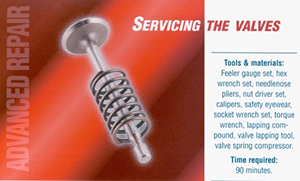
In order to properly inspect your engine valves for maintenance or repair, you need to remove them from the engine. Find the type of engine valve retainer and follow our step-by-step guide below
How to Reach The Valve Chamber
NOTE: Always wear safety eyewear when removing and installing valves.
- Step 1: Remove the spark plug and securing the spark plug lead away from the spark plug.
- Step 2: Remove the muffler, crankcase breather and any other components that block access to the valve chamber.
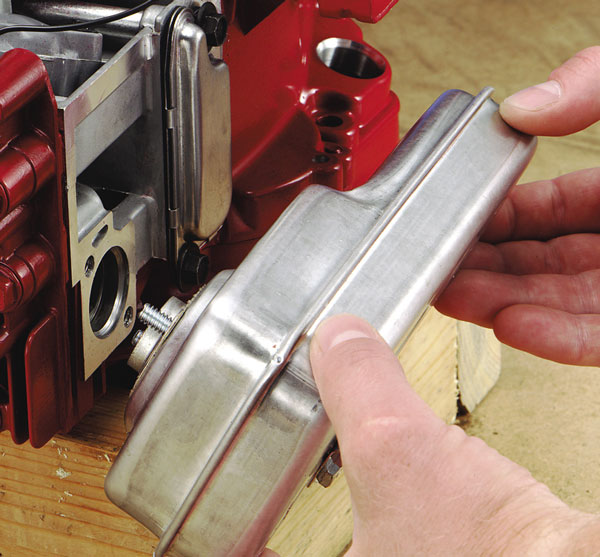
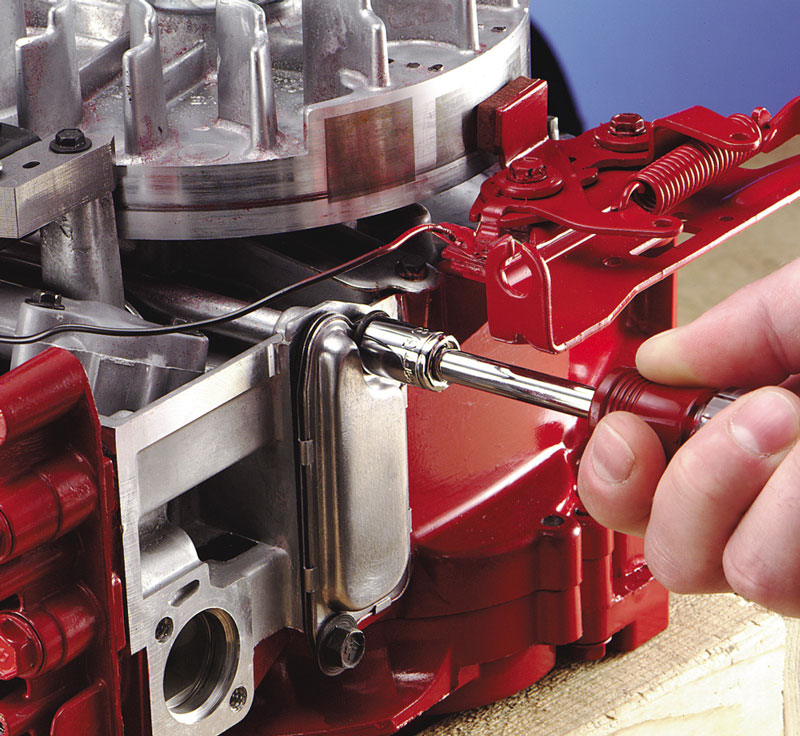
- Step 3: Remove the cylinder head bolts and take out other bolts from the engine components to reach the valve chamber. Label the bolts if necessary, to ensure proper installation later, since they may be of different lengths.
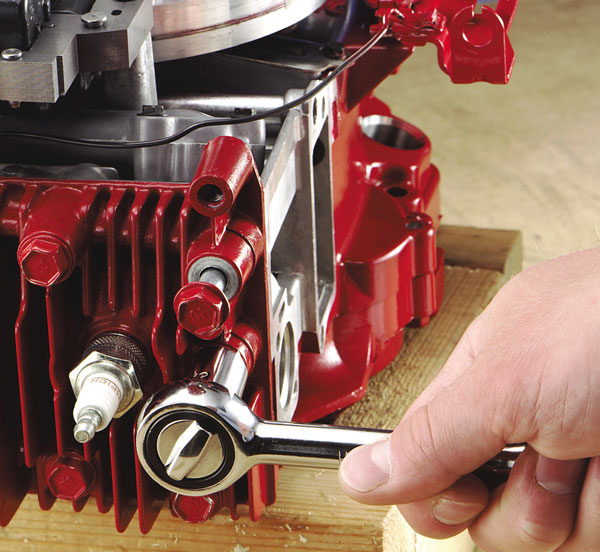
Removing Valves: Automotive Type or Pin Retainers
- Step 1: Remove the spark plug and securing the spark plug lead away from the spark plug.
- Step 2: After removing the spark plug and securing the spark plug lead away from the spark plug, adjust the jaws of the valve spring compressor (part number 19063) until they touch the top and bottom of the valve chamber

- Step 3: Push the tool in until the upper jaw slips over the upper end of the spring. Tighten the jaws to compress the spring
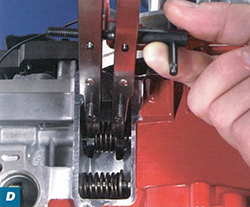
Step 4: Remove the retainers and lift out the valves, compressors and springs.
Removing Valves: Keyhole Retainers
Removing the valves for keyhole retainers requires some patience. Remember that the retainer’s key-shaped slot will help you slip the retainer off the valve stem, even when the retainer is hidden from your view by the valve spring compressor.
- Step 1: Remove the spark plug and securing the spark plug lead away from the spark plug.
- Step 2: Slip the upper jaw of the valve spring compressor over the top of the valve chamber and the lower jaw between the spring and retainer. If the engine design does not permit the upper jaw to fit over the top of the valve chamber, insert the upper jaw into the chamber over the top of the spring, so that the spring is between the tool's jaws
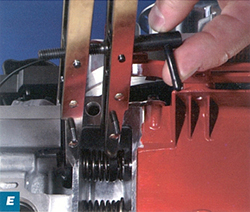
- Step 3: Rotate the handle on the valve spring compressor clockwise to compress the spring. Then, slide the retainer off the valve by shifting it with needle nose pliers so that the large part of the keyhole is directly over the stem. Use the pliers to remove the retainer from the valve chamber.
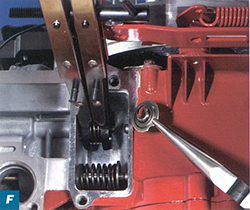
- Step 4: With the valve spring compressor clamping the spring, remove the tool and spring from the chamber. Then, slowly crank open the valve spring compressor to release the tension and remove the spring
Removing Overhead Valves
Overhead valve designs vary from one engine model to another. The parts and servicing steps in your overhead valve cylinder may differ from the approach that follows, which is based on the Briggs & Stratton Intek 6-HP single-cylinder OHV. The Intek does not require the use of a valve spring compressor, making valve removal and installation simple.
- Step 1: Remove the spark plug and securing the spark plug lead away from the spark plug.
- Step 2: Remove the air cleaner assembly, fuel tank, oil fill tube, blower housing and rewind starter, muffler guard, muffler, carburetor and any other engine parts that block access to the cylinder head.
- Step 3: Remove the screws from the valve cover, using a socket wrench or nut driver.
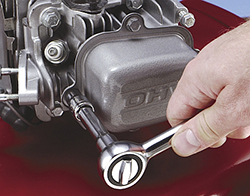
Then, remove the valve cover, breather valve assembly (if equipped) and any gaskets.
- Step 4: Remove the rocker arm bolts with a socket wrench or nut driver. Then remove the rocker arms and push rods.
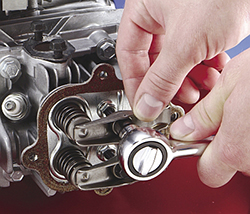
- Step 5: Remove the valve caps (if equipped). They are seated on the valve stems.
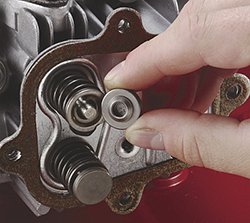
- Step 6: Use your thumbs to press in on the spring retainer and valve spring over one of the valves. With the valve spring compressed, remove the retainer.
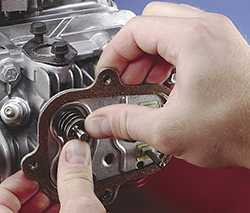
If your engine uses a keyhole retainer, line up the large slot in the retainer with the valves stem and release the spring slowly so that the stem slips through the large slot. Then, repeat the procedure for the other valve.
- Step 7: Remove the push rod guide bolts and push rod guide.
- Step 8: Remove the cylinder head bolts and remove the cylinder head by rocking it with your hands. If necessary, loosen the cylinder head by striking it with a nylon-faced hammer. Never pry it loose, as this may damage the head.
- Step 9: Remove and inspect the valves, guides and seats following the steps below. The intake and exhaust valves often are made of different steel alloys and may be different colors.
How Do I Check or Repair My Engine Valves?
Before trying to repair your valves, look them over carefully. Residue on the valves may help you identify a specific engine problem.
Gummy deposits on the intake valve go hand in hand with a decrease in engine performance, often because the engine has been run on old gasoline. Hard deposits on either valve suggest burning oil, which has several possible causes.
Follow the steps below to check for the most likely sources of engine valve problems.
- Step 1: Check the valve face for an irregular seating pattern. The pattern around the face should be even with the valve head and of equal thickness all the way around. It there are stubborn deposits, clean the valve with a wire brush and solvent, soaking the parts for several hours if necessary, to loosen hardened grit.
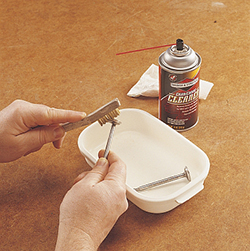
- Step 2: Run a fingernail or credit card along the valve stem once you have cleaned it. If you feel a ridge, the valve stem is worn and should be replaced. The valve guide may also be worn and in need of a replacement.
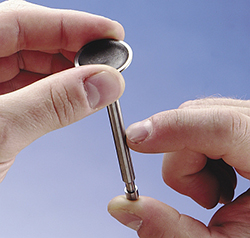
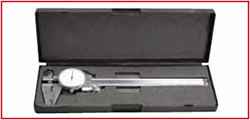
Step 3: Measure the thickness of the valve head, known as the valve head margin, using a caliper (part number 19199).
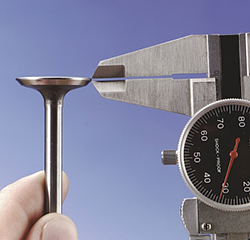
- Step 4: Examine the surfaces of the valve face and seat. An uneven wear pattern tells you it's time to replace them or resurface the seat and replace the valve.
- Step 5: Check that both valve springs are straight. Replace either valve spring if it is bent.
- NOTE: The exhaust valve spring may use thicker wire than the intake valve spring.
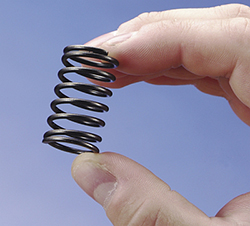
Valve Maintenance: Lapping Valves
If there are no signs of damage or valves wearing out after inspection, you can tune up the valves and seats so that the valves seal effectively (also known as “lapping the valves”).
How to Lap Valves
You can smooth out minor scoring and pitting of the valve face and seat to restore a valve's ability to seal the combustion chamber by lapping the valves. While lapping valves, make sure to check your progress often because it’s easy to remove the carbon building as well as the metal, further damaging the valve or seat.
- Step 1: Apply a small amount of valve lapping compound (part number 94150) - a fine, but abrasive paste- to the valve face and insert the valve into the valve guide.
- Step 1: Apply a small amount of valve lapping compound
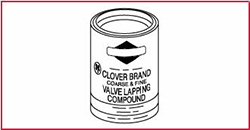
- Step 2: Wet the end of the lapping tool suction cup and place it on the valve head. Spin the valve back and forth between your hands several times. Lift the tool, rotate 1/4 turn and spin again.
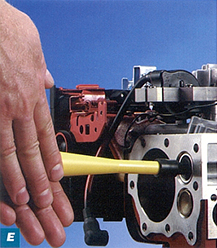
- Step 3: Clean the surface frequently and check your progress. Lap the valve just enough to create a consistent and even pattern around the valve face.
- Step 4: Once lapping is completed, clean the valves thoroughly with solvent to ensure that ALL of the abrasive residue is removed. Any particles that remain can rapidly damage the valves and other engine components.
Re-installing Valves after Repair & Maintenance
How to Reinstall Valves With Pins Or Automotive-Type Retainers
Note: Wear safety eyewear while reinstalling valves to protect yourself from the possibility of a flying springs.
- Step 1: Place the valve spring into the valve spring compressor and rotate the tool's handle until the spring is fully compressed.
- Step 2: Insert the compressed spring into the valve chamber.
- Step 3: Brush the valve stem with valve stem lubricant
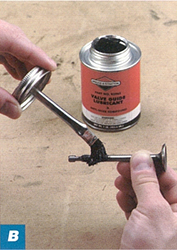
Then, lower the valve stem through the spring.
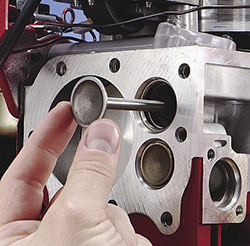
Hold the spring toward the top of the chamber and the valve in the closed position.
- Step 4: If pins are used, insert each pin with needle nose pliers. If automotive-type retainers are used, place the retainers in the valve stem groove.
- Step 5: Lower the spring until the retainer fits around the pin or automotive-type retainer. Then, pull out the valve spring compressor.
- Step 6: Reinstall the crankcase breather and other engine components.
How to Reinstall Valves With Keyhole Retainers
Once again, safety eyewear is absolutely necessary. Remember: a spring that is under tension can pop loose and fly through the air.
- Step 1: Valves with keyhole retainers do not require an additional retainer. Compress the keyhole retainer and spring with the compressor tool - the large hole should face the opening in the tool - until the spring is solid.
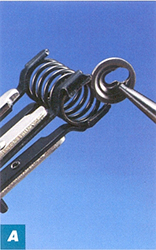
- Step 2: Brush the valve stem with valve stem lubricant.

- Step 3: Insert the compressed spring and retainer into the valve chamber
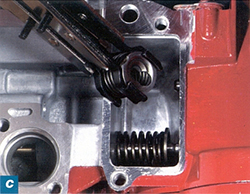
- Step 4: Insert the valve stem through the large slot in the retainer.
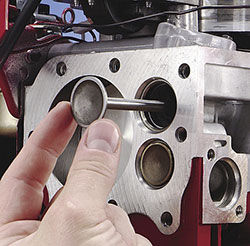
- Step 5: Reinstall the crankcase breather and other components.
How to Reinstall Overhead Valves
- Step 1: Check that valve stems and guides are free of debris and burrs. Then, lightly coat the valve stems with valves guide lubricant and insert them in the cylinder head, taking care to place the correct valve in each valve guide.
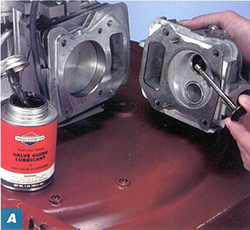
- Step 2: Place the push rod guide on the cylinder head and attach the mounting bolts, using a torque wrench. Coat the rocker arm stud threads with a hardening sealant and install the rocker arm studs, using a socket wrench.
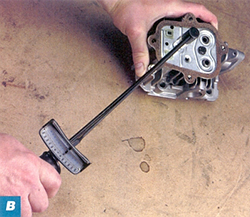
- Note: Consult your Authorized Briggs & Stratton Dealer for the proper torque settings for the mounting bolts and studs.
- Step 3: Lubricate the inside diameter of each valve stem seal (if equipped) with engine oil and install the seals on the valve stems. Press them into place.
- Step 4: Install a valve spring and retainer over each stem.
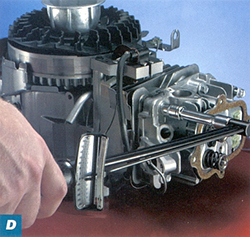
- Use both thumbs to compress the spring until the valve stem extends through the large end of the keyhole slot. Check that the retainer is fully engaged in the valve stem groove. Repeat this step for the other valve.
Step 5: Coat the threads of the cylinder head bolts with valve guide lubricant. Install a new cylinder head gasket on the cylinder, insert the bolts in the cylinder and position the cylinder head on the cylinder. - Step 6: Tighten the cylinder head bolts in increments, using a torque wrench. Turn each bolt a few turns, then proceed to the next bolt until each bolt is just snug. Then, for final tightening, proceed in increments of roughly one-third the final torque.
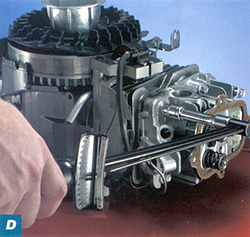
- Note: Consult your Operator's Manual for final torque specifications. Uneven tightening is likely to warp the cylinder head.
- Step 7: Install the push rods through the push rod guides and into the tappets.
- Type of Push Rod Based on Engine:
Single Cylinder OHV - Model Series 260700, 261700 upper push rod (exhaust) is hollow. Model Series 28N700, 28Q700, 28U700, 28W700, 287707, 310700, 312700, 313700 exhaust push rod has a red band of paint for identification and is steel. - Intek V-Twin OHV - Intake push rods are aluminum.
- Vanguard V-Twin - All models (except 540000, 610000) exhaust valve push rods are aluminum. Model Series 540000 and 610000, all push rods aluminum.
- Step 8: Install the caps on the ends of the valves and wipe away any lubricant. Then, install the rocker arm assemblies while holding the rocker arms against the valve cap and push rod.
Installing Rock Arm Assemblies
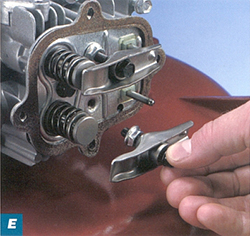
- Step 8: Install the caps on the ends of the valves and wipe away any lubricant. Then, install the rocker arm assemblies while holding the rocker arms against the valve cap and push rod.
Adjusting Tappet Clearances & Overhead Valves
How to Adjust Tappet Clearances
Since lapping valves removes a small amount of material from the surfaces of the valve face and valve seat, you may need to adjust the tappet clearances - the spacing between the valve stem and the tappet - after lapping and reinstalling the valves. Ask your Briggs & Stratton Authorized Dealer near you for the correct tappet clearance for your engine.
Step 1: With each valve installed in its proper guides in the cylinder, turn the crankshaft (clockwise as viewed from the flywheel end of the crankshaft) to top dead center. Both valves should be closed. Then, turn the crankshaft past top dead center until the piston is 1/4" down from the top of the cylinder.
Note: This procedure should be repeated for each cylinder on Opposed Twin and V-Twin engines.
Step 2: Check the clearance between each valve and its tappet, using a feeler gauge
Step 3: If clearance is insufficient, remove the valve and grind or file the end of the valve stem square to increase the clearance. Check the length frequently as it is easy to remove too much metal.
Step 4: Once the individual valve parts have been thoroughly cleaned, lubricate the valve stems and guides, using valve guide lubricant. Then, make certain there is NO lubricant on the ends of the valve stems or tappets.
How to Adjust Overhead Valves
- Step 1: Release the brake spring. Then, turn the flywheel to close both valves.
- Step 2: Insert a narrow screwdriver into the spark plug hole and touch the piston. Turn the flywheel clockwise past top dead center until the piston has moved down 1/4". Use the screwdriver to gauge the piston's range of motion.
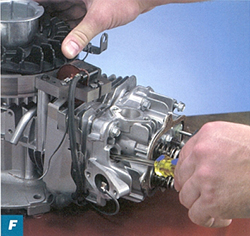
- PLEASE NOTE: This procedure must be performed for each cylinder on V-Twin engines.
- Step 3: Check the valve clearance by placing a feeler gauge between the valve head and the rocker arm. Clearances differ for the two valves and typically range from .002 - .004" to .005 - .007".
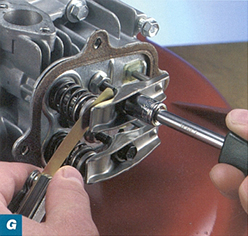
- Step 4: Adjust the clearances as required by turning the rocker screw. Once adjustments are completed, tighten the rocker nut.
- Step 5: Install the valve cover, using new gaskets, as required, and make sure the cover is secure.




